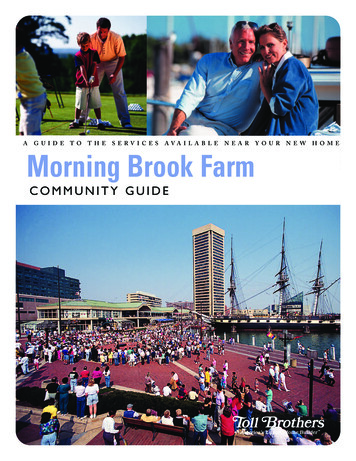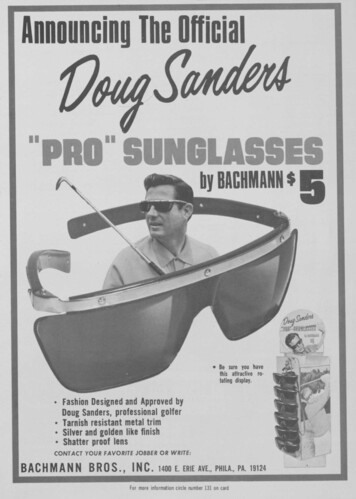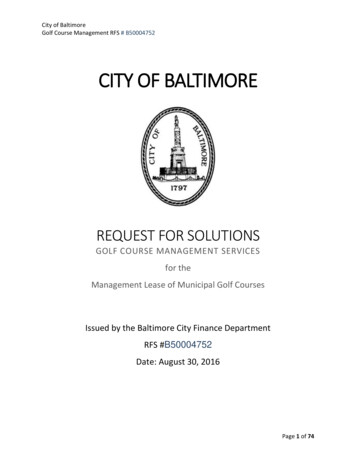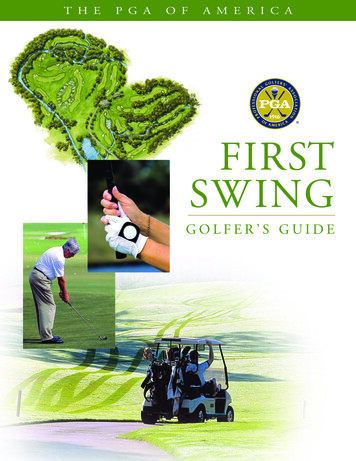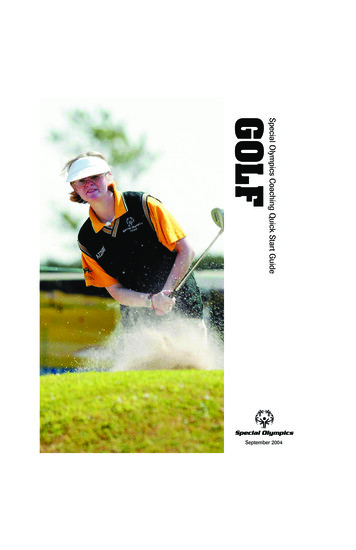
Transcription
ching Quick Start GuideFSeptember 20
Special Olympics GolfCoaches Quick-Start GuideTable of ContentsBuilding a Practice SchedulePage 3Essential Components of the Training SessionPage 4Training Session PlanPage 6Sample Eight-Week Lesson PlanPage 7Sample Eight-Week Level II-V Lesson PlanPage 8Training Principle SummaryPage 9Principles of Strength Training and Conditioning At-A-GlancePage 10Safety Hints for Your Training SessionPage 11Golf Skill Assessment CardPage 12Golf EquipmentPage 13Proper (Preferred) Golf AttirePage 14NutritionPage 15The Rules of GolfPage 16EtiquettePage 16A Summary of the Rules of GolfPage 18DefinitionsPage 23Appendix AStretching, Exercises and DrillsPage 29Appendix BSkill Development Tips2Page 37Special Olympics Golf Quick Start GuideCreated: September 2004
Special Olympics GolfCoaches Quick-Start GuideBuilding a Practice ScheduleBelow are factors to consider when planning your training season, schedule and budget.Safety FirstVenue AssessmentThe Golf Course, Practice Areas or Playing FieldTurf/Floor conditionsLevel gradeForeign objectsObstructions to practice or play areaInclement weather optionsAdaptations required to facility (indoor/outdoor)EquipmentDetermine your Equipment NeedsNumber of clubs and golf balls available per athleteProper size and fitSelection availableMaintenanceStorageAthletesFocus on AbilityKnow any physical, social or medical concerns and the golf experience of each athlete.It is important to administer the Golf Skills Assessment early in the season. This test enables you to determinethe ability range of each athlete so you can set personal goals for improvement.The physical preparation of the athletes is important. Following are the major fitness components to incorporateinto the training process. Each athlete will perform differently in the same training process because of physicaland intellectual limitations.Flexibility: Stretching RoutineMuscular Fitness: Strength, Endurance, Power, SpeedCardiovascular EnduranceVolunteersGolf knowledgeableCoaching experienceCommitmentCompleted training and orientationAthlete-to-coach ratioSpecial Olympics Golf Quick-Start GuideCreated: September 20043
Special Olympics GolfCoaches Quick-Start GuideTransportationAssure athletes and volunteers have transportation to and from sessions.Proper Golf Attire (including footwear)Confirm appropriate dress code of facility.Essential Components of the Training SessionsThere are many ways to organize a training session for Special Olympics athletes. Because of comprehension andmemory challenges for the athlete, there is considerable value in a developing a consistent training routine thatprovides familiarity, stability and comfort.There are four essential components of a typical training session: warm-up and stretching, skills instruction,competition experience, and cool-down and stretching. (Fitness training or conditioning also can be included followingcompetition experience and prior to cool-down.) The following techniques and tips will provide the most successfullearning opportunities.Warm-up and StretchingTime is precious and skills repetition vital. Warm up in a way specific to golf.When athletes have difficulties with balance, use stretching activities that can be done while sitting, lying downor leaning against a wall or partner.Involve athletes in leading the exercises; coaches are then free to circulate and directly assist others who needhelp.Teach a simple routine involving the major muscle groups, which athletes can repeat at home and atcompetition. Warm up by walking or jogging five minutes. Then perform the following stretches:1)2)3)4)5)6)calf stretch against wall;hamstring stretch or toe touch;quad stretch holding onto wall for balance (both directions);groin stretch while sitting or lunging to each side;shoulder stretch (grasping hands behind body and leaning forward; andtriceps stretch (reaching to sky with one arm, bending elbow which points forward and pulling elbowstraight back with opposite hand; perform stretch with other arm).Following is what to do and not to do when stretching:Do4PreventionPerform warm-up activity for 5 minutes (walk or runslowly).Muscle fiber tear or strainPerform held stretches for 10-30 seconds each.Muscle fiber tear or strain.Start with the large muscle groups such as the legs, thenmove to the shoulders, etc.Greater energy required warming large musclegroups. Circulation and heart rate is increasedimmediately.Perform each stretch to your personal point of tension.Strain on the joints, back or neck.Breathe while stretching.Releases tension and increases oxygen flow tomusclesPerform stretches in a safe position and through range ofmotion.For example, perform a sit-up crunch with back flatto ground to avoid stress on lower back.Special Olympics Golf Quick Start GuideCreated: September 2004
Special Olympics GolfCoaches Quick-Start GuideSkills InstructionThe key is to break skills into small basic tasks or steps; tasks are then put together to form skills. (Addressesdifficulty in performing multi-step tasks)Drills are developed so that skills can be applied in a game situation. The result is skills performed incompetition.Communication when Teaching and CoachingCommunicate effectively.Concise: Use a few descriptive keywords. . Do not use long sentences. For example: Reach for the sky.(Addresses difficulty in understanding verbal instructions and desired actions)Consistent: Use the same word or words for the same action. (Addresses need for repetition andreinforcement)Command-oriented: Verbally reinforce the athlete immediately after a desired action. Make thereinforcement action-oriented and specific to the skill. (Addresses need for frequent motivation and wordsassociated with a physical action)Make sure an athlete is looking at you when making a coaching point. When needed, physically prompt anathlete to look at you. (Addresses difficulty in maintaining attention)Ask athletes questions rather than always providing directions. Lead them to think for themselves. Verifyathlete responses. (Addresses independence )Levels of Instruction: Skills ProgressionAssess what an athlete is ready to do; build upon strengths.Use appropriate levels of assistance for each athlete verbal, visual (demonstration), physical prompt, physicalassistance. Gradually reduce physical assistance in favor of simple cues and, eventually, no prompting at all.(Addresses difficulty in learning and improving)The lower the athlete s ability level, the more assistance may be required.Verbal cues should always be accompanied by demonstration.Physical prompts may be needed to help the athlete get positioned properly.When all else fails, move the athlete through the complete skill.Practice skills in situations that are related to the game or event. (Addresses difficulty in generalizing to newsituations)Use drills and activities that involve many athletes at all times. (Addresses slower rate of learning and the needfor motivation and repetition)Competition ExperienceProvide a realistic competition experience during each practice in order to improve confidence and performanceunder the pressure of real competition.Help athletes understand game concepts by providing immediate and concrete feedback. During scrimmages orpractice games, stop the play to help athletes recognize critical situations and learn how to react successfully.Emphasize the value of enforcing the rules during training. Rules enforcement helps prepare athletes forparticipation in community sports and in life.Cool-down and StretchingHaving athletes do light jogging and then stretching major muscle groups will prevent muscle cramps andsoreness and increase flexibility.Review the main themes of the training session, reward athlete performance and talk about the next competitionor training session.Special Olympics Golf Quick-Start GuideCreated: September 20045
Special Olympics GolfCoaches Quick-Start GuideTraining Session PlanSport: GolfDate:# of Athletes:# of Coaches:Goals for training session: Using Mini-Swing and lofted club, develop target and distance control for the chipFacility safety check:TimeEquipmentSessionPractice AreaCourse LayoutSpecific e, Review Session, Assign StationsEquipment:Warm-up:After Warm-up:Stretching:With Club:SkillsInstruction: Explain, DemonstrateCompetition Experience:Rules/Strategy :Group Discussion/ ReviewRemind about change time for next weekDismiss6Special Olympics Golf Quick Start GuideCreated: September 2004
Special Olympics GolfCoaches Quick-Start GuideSample Eight-Week Lesson PlanWeek 11. WelcomeIntroduce the game of golfGo over safety proceduresProgram contentDemonstrate warm-up exercises2. Opening remarksSwing demonstrationEquipment explanationWarm-up exercisesSkill assessmentsWeek 51.2.Week 21.Opening remarksReviewWarm-up exercisesDemonstrate proper stanceHave athletes assume stances of other sports toshow similarityGame: Range Ball Relay2. ReviewWarm-up exercisesDemonstrate arm swingHave athletes perform elephant trunk exerciseReview safety rulesGame: Range Ball RelayWeek 61.2.Week 3ReviewWarm-up exercisesIntroduce pivotUse hands to place athletes in proper positionsThrow tennis balls underhanded to show propermovementGame: Range Ball Relay2. ReviewWarm-up exercisesIntroduce the gripStress safety rulesDemonstrate hand actionUse hands-on technique to place athletes hands inproper positionGame: Range Ball Relay1.ReviewWarm-up exercisesDemonstrate basic golf swingTeach movement progressionGo over safety with a clubIntroduce grass-cutting swing drillConduct acceleration test (tennis ball)Game: Open Fairway2. ReviewWarm-up exercisesBalance drillIntroduce club, ball and targetDemonstrateAcceleration test with tennis ballsGame: Open FairwaySpecial Olympics Golf Quick-Start GuideCreated: September 2004ReviewWarm-up exercisesIntroduce mini-swing and demonstrateReview club safetyUse clock hand systemGame: Tee to TargetReviewWarm-up exercisesHave athletes roll with underhand tossHave athletes roll ball with a putter differentdistancesHave athletes roll ball by hand to a targetSet up a putting courseGame: Hole Out Relay or Crack Putters OpenWeek 71.2.Week 41.ReviewWarm-up exercisesIntroduce the golf swing progressionSet up partner formation for chip, pitch and catchSet up partner formation. Use clock hand systemStress that the swing is a continuous motionGame: Tee TrackReviewWarm-up exercisesUse partner formation for chip, pitch and catchwarm-up; Review target concept and aimingGame: Tee to Target or Range Ball RelayReviewWarm-up exercisesIntroduce chipping and pitchingReview mini-swing and half-swingDemonstrateStress proper hand actionHave athletes use different clubsGame: Field Goal Golf or Leap FrogReviewWarm-up exercisesReview pitching and chippingPlay tee me - pitch meGame: Golf BocceWeek 81.2.ReviewWarm-up exercisesDemonstrate full swingReview club safetyDemonstrate swing sequenceUse tennis balls on a teeGame: Bullseye Golf or Death or GloryReviewWarm-up exercisesReview golf swing principlesCover basic rules of golf and etiquetteSet up a short course and have athletes playGame: Scramble7
Special Olympics GolfCoaches Quick-Start GuideSample Eight-Week Level II-V Training L esson PlanCoaches may follow the skills training progression in the above eight-week lesson plan; however, your goal would be toget Level 2-5 athletes playing golf as much as possible. If you do not have access to a course, please refer to the lead upgolf games and activities in the Teaching Sport Skills section. Rules, etiquette, safety and on-course strategy should bepart of every plan.Week 11. WelcomeIntroduce the game of golfGo over safety proceduresProgram content and handbookDemonstrate warm-up exercises2. Opening RemarksSwing demonstrationEquipment explanationWarm-up exercisesSkill assessmentsWeek 21. WelcomeReviewWarm-up exercisesDemonstrate basic golf swingTeach movement progression ( tee line)Balance Drills2. Review SafetyBasic Rules/EtiquettePutting ContestChipping ContestWeek 31. WelcomeReviewWarm-up exercises2. Introduce target awareness and club selectionHit balls to designated targets starting withshort yardages and working outDemonstrate3. Play 3 holes: 4-Person ScramblePost scores4. Rules of the weekWeek 51. WelcomeRules, Safety, Etiquette Test2. Warm-up exercisesGolf Ball Race (first hole)3. Holes 2 4, play assigned level formatPost scoreReview course strategyWeek 61. WelcomeReview Rule of the WeekWarm-up exercisesHit ballsDistribute Round Chart CardExplain record keeping2. Play 4 holes, designated format levelPost scoresReview Chart CardRule of the WeekWeek 71. WelcomeWarm-up exercisesReview Round Chart CardWork on area of weakness2. Alternate Shot CompetitionReview pre-shot routineRule of the WeekWeek 8Level 2 5: 9-Hole CompetitionWeek 41. WelcomeReviewWarm-up exercisesChip and PuttFull shots on range2. Level 2 and 4: Play 4 holes: 2-Person ScrambleLevel 3 and 5: Individual Stoke PlayScore and discuss Rule of the WeekPrepare for Rules Test8Special Olympics Golf Quick Start GuideCreated: September 2004
Special Olympics GolfCoaches Quick-Start GuideTraining Principles SummaryLaw of OverloadBody adapts to training loads explains how training worksAdequate training loads improve overall fitness and increase performanceFactors impacting training load: frequency, duration and intensityLaw of ReversibilityTraining loads that increase progressively create higher fitness levelsNo increase in fitness if loading is too far apart or stays the sameOver-training or incomplete adaptation occurs when training loads are too great or too closeLaw of SpecificitySpecific training load produces specific response and adaptationsGeneral training prepares athletes for specific trainingThe greater the volume of general training, the greater the capacity for specific trainingPrinciple of IndividualismAthletes bring their unique talent, capabilities and capacities to trainingHeredity determines many physiological factors that impact trainingChronological, biological and training ages must be considered when designing a trainingand competition planPrinciple of VarietyTraining is a long-term process and loading and recovery can become boringMake it fun for the athletesBe creativePrinciple of Active InvolvementAthletes have to want to actively and willingly participate in their training programAthletes have to be committedAll aspects of athletes lives contribute to their athletic successSpecial Olympics Golf Quick-Start GuideCreated: September 20049
Special Olympics GolfCoaches Quick-Start GuidePrinciples of Strength Training and ConditioningA t -A -GlanceStrength and conditioning training is designed to assist athletes in their overall development. There are two types ofstrength training programs: general and specific. The exercises used in each program reflect the athletes need forstrength development. A general strength and conditioning training program gives athletes extra strength in theparticular muscles that are needed to perform well in their sport-specific events. In addition, strength and conditioningtraining can help to prevent injury to athletes by building healthier, flexible and stronger muscles and bones.FlexibilityStretch slowly and with controlDo not bounce or feel painBreathe slowly and rhythmically; do not hold your breathEasy stretch: slight tension to no tension hold for 5-12 secondsDevelopmental stretch: stretch further, feeling slight tension again hold for 15-30 secondsMuscle BalanceTrain both the front and the back muscles when strength trainingExample: if training the biceps, also train the tricepsImportant in preventing injurySelection of ExercisesEmphasize total body conditionOrder of ExercisesVery important in getting the most out of each exerciseExercises and lifts that work many muscle groups and require more mental concentration perform earlyin the workoutExercises and lifts that work small muscle groups and require little concentration perform last in theworkoutFrequency of TrainingAlways include one day of rest between strength training workoutsNumber of SetsOne set of each exercise is recommended during the first or second week of training. Increase thenumber of sets as your training program progresses.Rest between SetsDepends upon the desired results of the workoutMuscular endurance: short rest period full recovery not requiredStrength and power: longer rest period full recovery requiredActive RestAn active period, recreational level, after the completion of a season of sportMay or may not include strength trainingGives athletes a break and their bodies time to regenerate and rest10Special Olympics Golf Quick Start GuideCreated: September 2004
Special Olympics GolfCoaches Quick-Start GuideSafety Hints for Your Training Session1.2.3.4.5.6.7.A golf club can be like a dangerous weapon. It should never be swung in a group.Athletes should be taught to swing in designated swing areas only.Always approach an athlete who has a club in the address position from the front, facing the athlete.Never position yourself or a student in the target line of a person swinging the club.Pair students so they share one club. One student can become the watchdog for the other.Establish a hitting line. No student should ever be allowed to hit in front of the established line.Students should hold their golf club at the club head end whenever an instructor is demonstrating or organizing.This discourages swinging the club.8. Teach students when to use the term FORE, and that using the term is not a substitute for following safetyprocedures.9. Athletes should be taught to use a stop-look-and-swing method prior to each swing when playing golf.10. In situations where close supervision is difficult, allow only half-swings or to hip height.Note: Half-swings incorporate all the fundamental movements of a full swing.Special Olympics Golf Quick-Start GuideCreated: September 200411
Special Olympics GolfCoaches Quick-Start GuideGolf Skills Assessment CardIf the athlete performs the skill correctly 3 out of 5 times, check the box next to the skill to indicate that the skill hasbeen accomplished.Your Athlete Can:NeverSometimesOftenEquipmentIdentify an ironIdentify a woodIdentify a putterThe Golf CourseIdentify the teeing groundIdentify the greenIdentify the hazards (water and bunker)ScoringUnderstand scoring terminologyKeep score (match and stroke play)Add scoreScore own scorecardGripPlace left (right) hand on the clubPlace right (left) hand on the clubPlace both hands on the club with palms facingGrip club with clubface in proper positionPosture and StancePlace feet in proper positionBend properly from the waistMaintain balance in this positionSwingDemonstrate proper arm swing without a clubDemonstrate swing sequence with a clubAddress and AimTake grip and stancePlace the club behind the ballAim both the club and the bodyEtiquette and SafetyCite three rules of safetyShow where to standDemonstrate basic care of the courseSportsmanshipDress correctlyObserve rules of etiquette and rules of the gameCooperate with other playersAcknowledge achievements of other playersTotals12Special Olympics Golf Quick Start GuideCreated: September 2004
Special Olympics GolfCoaches Quick-Start GuideGolf EquipmentYou will need the following equipment to conduct your skills training sessions:1 golf club per student (or pair of students). A lofted iron is preferred (#9, 8, 7, 6, 5)1 putter per pair of students. #1, 2, 3 irons also may be used as putters10 golf balls per student1 tennis ball per student for introductory games2 regular-size whiffle or plastic balls per student1 square of carpet remnant per student.Because the carpet is used for floor protection for indoor classes, the pile should be thick enough to protect thefloorLevel II-V athletes are responsible for providing their own equipmentat competition for on-course play:A set of clubs shall include at least one wood, one iron andone putter.A golf bagGolf ballsPitch mark repairerEquipment SourcesGolf professionalsGolf club membersGolf associationsEquipment manufacturersThrift shopsParks and Recreation DepartmentsSchool Physical Education DepartmentsSporting goods retail shopsSpecial Olympics Golf Quick-Start GuideCreated: September 200413
Special Olympics GolfCoaches Quick-Start GuideProper (Preferred) Golf AttireGolf shirt: Shirt with collarSlacks or shortsFootwear: Golf shoe (soft spikes)Sneakers or smooth-soled shoesUniformsIt is important to confirm appropriate golf attirefor both training and competition. Manycourses have very strict dress codes that mustbe adhered to.AthletesRecommended golf attire:Shirt with collar, tucked into pants/shorts/skirt.Golf shoes with spikes (soft or metal).Smooth-soled athletic shoes will suffice if golf shoes are not available.Proper attire should be stated in the Coaches, Players, Volunteers and Official handbooks.OfficialsVolunteer officials may be requested to wear certain bottoms, shirts or headwear. Golf car indicators or official locationblocks are suggested as well. To expedite requests for rulings or questions, all participants should be informed of golfhole assignments of official locations. The uniform, golf car indicator signage and official locations can easily beincluded on the Rules of Play Sheets and distributed at the coaches meetings.14Special Olympics Golf Quick Start GuideCreated: September 2004
Special Olympics GolfCoaches Quick-Start GuideNutritionGuidelines for a Balanced DietEats lots of different kinds of food vegetables, fruits, fish, meats, dairy, produce and grainsEat fresh food rather than prepared, canned or frozen foodsEat a high proportion of carbohydrate-rich foodsGrill, steam or bake foods. Avoid boiling or fryingAvoid fatty meals and sweet and salty snacksCheck fiber intake by eating whole grain breads, cereals, pastasEat brown rice instead of white riceFlavor food with herbs and spices rather than saltDrink small amounts of water and fruit juices oftenPre-Competition Meal/NutrientsThe body s energy levels need to be high before training and competition. The high-performance diet above will supplythis everyday requirement. Athletes are individuals and require different foods. Also, their bodies respond differently tocertain foods. Generally speaking, the guidelines below will help your athletes consume the proper nutrients beforecompetition.Eat a small, easily digestible meal, usually less than 500 caloriesEat about 2½-4 hours before competingLimit proteins and fats because they digest slowlyAvoid foods which form gas in digestive systemDrink small amounts of water often before, during and after competingDuring Competition NutrientsBesides hydration, nutrients are not needed for events that last less than one hour.For events that have more than one hour of continuous activity, carbohydrate drinks or fruit will supply theneeded energy for continued effort.Post-Competition NutrientsTo replenish energy, foods with readily available carbohydrates (fruit, carbohydrate drink, granola bars) shouldbe eaten in small amounts immediately following exercise.Throughout the remainder of the day, meals should contain 65 percent complex carbohydrates to replenishenergy.Special Olympics Golf Quick-Start GuideCreated: September 200415
Special Olympics GolfCoaches Quick-Start GuideT he Rules of GolfGolf is a game. But remember, every game has its rules. The official Special Olympics Sports Rules shall govern allSpecial Olympics Golf competitions. Special Olympics has created these rules based upon The Rules of Golf asgoverned by the Royal and Ancient Golf Club of St. Andrews (R& A) and the United States Golf Association. Toenjoy a fair match and protect the integrity of competition, it is important know and understand the basic rules of thegame.EtiquetteCourtesy on the Course1. If someone else is playing from the tee, do not tee your ball until he or she has played2. Always stand still and to the side of rather than behind another player when he or she is playing. Do not talk.3. Be ready to play when it is your turn.4. When you are playing slowly or looking for a lost ball, ask the group behind you to play through so you do notslow everyone down.5. Write down scores on the way to the next hole, not on the green you are leaving.6. Never take more than one practice swing, if any.Safety FirstBoth in practice and play, always make sure that:No one is near you when you swing the club; andNo one is ahead of you where your shot might hit them.16Special Olympics Golf Quick Start GuideCreated: September 2004
Special Olympics GolfCoaches Quick-Start GuideTaking Care of the Course1.Always wear golf or tennis shoes. Do not slide or drag your feet on the green.2.Always rake a bunker after you have played from it.3.Replace divots and repair depressions made when your ball hits the green. These are called ball marks.4.Never place your golf bag on the green. Put the flagstick carefully back into the hole after putting,Special Olympics Golf Quick-Start GuideCreated: September 200417
Special Olympics GolfCoaches Quick-Start GuideA Summary of the Rules of GolfRule 1 - The Gamea.The holes of the course must be played in order (1 through 9, 10 through 18).b.You must always play by the Rules. You are not allowed to change them.Rule 2 - Match Playa.In match play, each hole is a separate contest. If you win the first hole, you are one UP ; if you lose it, you areone down ; if you tie it, you are all square.b.You have won the match when, for example, you are three up and there are only two holes left to play.c.Anyone you are playing against is your opponent.Rule 3 - Stroke Playa.In stroke play, the stipulated competitor with the lowest total score for the round is the winner.b.You must play the ball into the hole before starting the next hole. No gimmies!c.Anyone you are playing with is a fel1ow competitor.Rules 4 and 5 - Clubs and the Balla.You may carry no more than 14 clubs.b.You may not change balls during the play of a hole.However, if you damage or cut your ball, you may change your ball after first asking your opponent or a fellowcompetitor.Rule 6 - Things a Player Should DoYou should:a.Read the notices given to you by the tournament officials.b.Always use your proper handicap.c.Know your tee time or starting time.d.Make sure you play your own ball (put a mark on the ball with a pencil in case someone else is using anidentical ball.e.In stroke play, make sure your score for each hole is right before you turn in your card.f.Keep playing unless there is lightning, you are ill or an official tells you to stop.Rule 7 - PracticeYou may not hit a practice shot during play of a hole, or from any hazard. Note: Always read the local rules aboutpractice.Rule 8 - Advice on How to Play18a.You may not ask anyone except your caddie or partner for advice on how to play; however, you may ask aboutRules or the position of hazards or the flagstick.b.You may not give advice to your opponent or a fellow competitor.Special Olympics Golf Quick Start GuideCreated: September 2004
Special Olympics GolfCoaches Quick-Start GuideRule 9- Advising Opponent on Strokes TakenIn match play, you must tell your opponent the number of strokes you have taken if you are asked.Rule 10 - When to Play a Shota.The player who has the lowest score on a hole has the right to play first on the next hole. This is called thehonor.b.During play of a hole, the player whose ball is farthest from the hole plays first.c.If you play out of turn in match play, your opponent may make you replay, but this is not so in stroke play.Rule 11 - Teeing Grounda.Tee your ball between the tee-markers or a little behind them. You may go behind them as much as two clublengths.b.If your ball accidentally falls off the tee, you may replace it without penalty.Rule 12 - Finding Ball in Hazard Identify Balla.A hazard is any bunker (area of sand) or water hazard (lake, pond, creek, etc.).b.In a bunker or water hazard, if your ball is covered by sand or leaves, you may remove enough of the sand orleaves to be able to see a part of the ball.c.You may lift your ball to identify it anywhere except in a hazard. You must tell your opponent or fellowcompetitor before you lift your ball to identify it.Rule 13 - Playing the Ball as It Lies and the Course as You Find Ita.You must play the ball as it lies; you may not move it to a better spot.b.You may not improve your lie by pressing down behind the ball. The club may be grounded only lightly behindthe ball.c.You may not improve the area of your intended swing or line of play by bending or breaking anything growing,such as tree limbs or weeds.d.In a hazard, you may not touch the sand, ground or water with the club before or during your backswing.e.In a hazard, you may not remove loose impediments (natural things, such as leaves or twigs) but you mayremove obstructions (artificial objects, such as bottles or rakes).Rule 14 - Striking the Balla.You must fairly strike the ball with the head of the club. You may not push, scrape or rake the ball,b.You must not hit your ball while it is moving.Rule 15 - Playing a wrong Balla.In match play, if you play a ball that is not yours, you lose the hole unless the wrong ball is played in a hazard;if you play a wrong ball in a hazard, you must then play the right ball.b.In stroke play, if you play a ball that is not yours, you must take a two-stroke penalty unless the wrong ball wasplayed in a hazard. You must then play out the hole with your own ball; if you do not do so, you aredisqualified.Special Olympics Golf Quick-Start GuideCreated: September 200419
Special Olympics GolfCoaches Quick-Start GuideRule 16 - The Putting Greena.If any part of your ball is touching the green, it is on the green.b.When your ball is on the green, you may brush away leaves and other loose impediments on your line of puttwith your hand or a club. Do not fan
Principles of Strength Training and ConditioningAt-A-Glance Page 10 Safety Hints for Your Training Session Page 11 Golf Skill Assessment Card Page 12 Golf Equipment Page 13 Proper (Preferred) Golf Attire Page 14 . Introduce the game of golf Go over safety procedures Program content and handbook Demonstrate warm-up exercises 2. Opening Remarks

